*NURSING > QUESTIONS & ANSWERS > Med Surg; GI quizzes: Medical-Surgical Adult Medical Surgical Test Bank_ Answered/Elaborated 2022 (All)
Med Surg; GI quizzes: Medical-Surgical Adult Medical Surgical Test Bank_ Answered/Elaborated 2022
Document Content and Description Below
A nurse is caring for a client who has a percutaneous endoscopic gastrostomy (PEG) tube and is receiving intermittent feedings. Prior to initiating the feeding, which of the following actions should t... he nurse take first? A. Flush the tube with water. B. Place the client in semi-Fowler's position. C. Cleanse the skin around the tube site. D. Aspirate the tube for residual contents. - Ans-B. Place the client in semi-Fowler's position. A nurse is caring for a client who is scheduled to undergo an esophagogastroduodenoscopy (EGD). The nurse should identify that this procedure is used to do which of the following? A. To visualize polyps in the colon B. To detect an ulceration in the stomach C. To identify an obstruction in the biliary tract D. To determine the presence of free air in the abdomen - Ans-A. A sigmoidoscopy or barium enema is used to visualize the lower gastrointestinal tract, where polyps are found. B. CORRECT: An EGD is used to visualize the esophagus, stomach, and duodenum with a lighted tube to detect a tumor, ulceration, or obstruction. C. Identifying an obstruction in the biliary tract is performed during endoscopic retrograde cholangiopancreatography (ERCP). D. The measurement of free air, which is a gas, is obtained using fluoroscopy or an x-ray, not an EGD. A nurse is teaching a client who has Barrett's esophagus and is scheduled to undergo an esophagogastroduodenoscopy (EGD). Which of the following statements should the nurse include in the teaching? A. "This procedure is performed to measure the presence of acid in your esophagus." B. "This procedure can determine how well the lower part of your esophagus works." C. "This procedure is performed while you are under general anesthesia." D. "This procedure can determine if you have colon cancer." - Ans-A. A pH probe study, which involves the insertion of a specially designed probe into the distal esophagus. is performed to monitor for the presence of acid in the normally alkaline esophagus. B. CORRECT: An EGD is useful in determining the function of the esophageal lining and the extent of inflammation, potential scarring, and strictures. C. An EGD is performed while the client receives moderate sedation. D. A colonoscopy is performed to detect colon cancer. A nurse is caring for a client who is dehydrated and is receiving continuous tube feeding through a pump at 75 mL/hr. When the nurse assesses the client at 0800, which of the following findings requires intervention by the nurse? A. A full pitcher of water is sitting on the clients bedside table within the clients reach. B. The disposable feeding bag from the previous day at 1000, and contains 200 mL of feeding. C. The client is lying on the right side with a visible dependent loop in the feeding tube. D. The head of the bed is elevated 20 degrees. - Ans-A. the nurse should monitor the clients intake and output and should observe the client for manifestations of dehydration, such as dry mucous membranes, thirst, and decreased urinary output. A pitcher of water at the clients bedside does not require intervention by the nurse. B. The clients feeding bag should be changed every 24 hrs. The 200 mL remaining in the bag is sufficient to last until the bag needs to be changed. Because the rate is 75 mL/hr, the nurse will need 150 mL to cover the 2 hr until the bag needs to be changed. The 50 mL left in the bag will ensure that the bag does not run dry, causing air to enter the clients stomach. C. This observation does not require intervention because the feeding is not by gravity, but by a pump. and is set at a constant rate. The clients side-lying position will not affect the pump's rate of flow unless the client is lying on the tubing. D. CORRECT: The head of the bed should be elevated at least 30. (Semi-Fowler's position) while the tube feeding is administered. This position uses gravity to help the feeding move down through the digestive system and lessens the possibility of regurgitation. A nurse is caring for a client who is receiving total parenteral nutrition (TPN) therapy and has just returned to the room following physical therapy. The nurse notes that the infusion pump for the client's TPN is turned off. After restarting the infusion pump, the nurse should monitor the client for which of the following findings? A. Hypertension B. Excessive thirst C. Fever D. Diaphoresis - Ans-A. A client experiencing fluid volume overload will exhibit hypertension. B. A client experiencing hyperglycemia will exhibit excessive thirst. C. A client who has an infection will have an increased temperature. D. CORRECT: The nurse should recognize that the client has the potential for the development of hypoglycemia due to the sudden withdrawal of the TPN solution. In addition to diaphoresis. other potential manifestations of hypoglycemia can include weakness, anxiety, confusion. and hunger. A nurse is caring for a client who has celiac disease. which of the following foods should the nurse remove from the client's meal tray? A. Wheat toast B. Tapioca pudding C. Hard-boiled egg D. Mashed potatoes - Ans-A. CORRECT: Celiac disease is an autoimmune disorder characterized by a permanent intolerance to wheat, barley, and rye. Wheat toast contains gluten and should be removed from the clients tray. B. Tapioca pudding is rich in dairy and does not contain gluten. Therefore, it is an acceptable food to include in the clients diet. C. A hard-boiled egg does not contain gluten and is a good source of protein. Therefore, it is an acceptable food to include in the client's diet. D. Mashed potatoes do not contain gluten and are a good source of protein and potassium. Therefore mashed potatoes are an acceptable food to include in the clients diet. A nurse is caring for a client who is scheduled to undergo a liver biopsy for a suspected malignancy. which of the following laboratory findings should the nurse monitor prior to the procedure? A. Prothrombin time B. Serum lipase C. Bilirubin D. Calcium - Ans-A. CORRECT: A major complication following a liver biopsy is hemorrhage. Many clients who have liver disease have clotting defects and are at risk for bleeding. Along with the prothrombin time (PT), the activated partial thromboplastin time (aPTT) and the platelet count should be monitored. Liver dysfunction causes the production of blood clotting factors to be reduced, which leads to an increased incidence of bruising nosebleeds, bleeding from wounds, and gastrointestinal bleeding. This is due to a deficient absorption of vitamin K from the gastrointestinal tract caused by the inability of liver cells to use vitamin K to make prothrombin. B. Serum lipase is monitored to detect pancreatic disease and does not need to be monitored prior to this procedure. C. Bilirubin is monitored to detect biliary obstruction and does not need to be monitored prior to this procedure. D. Calcium is monitored to detect kidney failure or pancreatitis and does not need to be monitored prior to this procedure. A nurse is assessing a client who is experiencing perforation of a peptic ulcer. Which of the following manifestations should the nurse expect? A. Increased blood pressure B. Decreased heart rate C. Yellowing of the skin D. Boardlike abdomen - Ans-A. The nurse should expect the client who is experiencing perforation of a peptic ulcer to exhibit manifestations of shock, including hypotension. B. The nurse should expect the client who is experiencing perforation of a peptic ulcer to exhibit manifestations of shock, including tachycardia. C. The nurse should expect a client who has liver disease to exhibit jaundice, or yellowing of the skin. D. CORRECT: The nurse should expect the client who is experiencing perforation of a peptic ulcer to exhibit manifestations of a boardlike abdomen and severe pain in the abdomen or back that radiates to the right shoulder. Vomiting of blood and shock can occur if the perforation causes hemorrhaging. A nurse is caring for a client who has a history of cirrhosis and is admitted with manifestations of hepatic encephalopathy. The nurse should anticipate a prescription for which of the following laboratory tests to determine the possibility of recent excessive alcohol use? A. Gamma-gluramyl transferase (GGT) B. Alkaline phosphatase (ALP) C. Serum bilirubin D. Alanine aminotransferase (ALT] - Ans-A. CORRECT: The GGT laboratory test is specific to the hepatobiliary system in which levels can be raised by alcohol and hepatotoxic drugs. Therefore, it is useful for monitoring drug toxicity and excessive alcohol use. B. ALP is elevated in biliary obstruction and most forms of liver dysfunction. It does not differentiate between alcohol and other causative factors for liver disease. C. The serum bilirubin test is used to detect the function of the liver and its ability to excrete bilirubin. Elevated levels can determine liver disease or biliary tract disease. D. The largest concentration of the enzyme ALT is found in liver tissue. However. it is also present in kidney, heart. and skeletal muscle tissues. Because it is elevated in various toes of tissue damage. it is not helpful in identifying excessive alcohol use. A nurse is providing dietary teaching to a client who has diverticulitis about preventing acute attacks. which of the following foods should the nurse recommend? A. Foods high in vitamin C B. Foods low in fat C. Foods high in fiber D. Foods low in calories - Ans-A. Vitamin C functions as an antioxidant as well as a coenzyme. It can be associated with prevention of cancer of the stomach. esophagus and colon. However, it does not improve or prevent acute diverticulitis attacks. B. Low-fat foods do not improve or prevent acute diverticulitis attacks. C. CORRECT: The result of long-term, low-fiber eating habits along with increased intracolonic pressure lead to straining during bowel movements, causing the development of diverticula. High-fiber foods help strengthen and maintain active motility of the gastrointestinal tract. D. Low-calorie foods do not improve or prevent acute diverticulitis attacks. A nurse is caring for a client who is 4 hr postoperative following a laparoscopic cholecystectomy. Which of the following findings should the nurse expect? A. Right shoulder pain B. Urine output 20 mL/hr C. Temperature 38.4 degrees C (101.1 degrees F) D. Oxygen saturation 92% - Ans-A. CORRECT: The client can experience pain in the right upper shoulder due to gas (carbon dioxide) injected into the abdominal cavity during the laparoscopic procedure, which can irritate the diaphragm and cause referred pain in the shoulder area. The pain disappears in 1-2 days. Mild analgesics and a recumbent position can help with client comfort. B. Urine output following surgery should be at least 30 mL/hr. Less than this amount can indicate hypovolemia or renal complications and should be reported to the provider immediately. C. A temperature greater than 38.4. C (101.1 F) can indicate infection and should be reported to the provider immediately. D. An oxygen saturation of less than 95% can indicate an impaired gas exchange following surgery and should be reported to the provider immediately. A nurse in the emergency dependent is caring for a client who has bleeding esophageal varies. The nurse should anticipate a prescription for which of the following medications? A. Famotidine B. Esomeprazole C. Vasopressin D. Omeprazole - Ans-A. Famotidine is an H2 receptor antagonist used to treat stress ulcers. B. Esomeprazole is a proton pump inhibitor used to treat gastrointestinal reflux disease. C. CORRECT: Vasopressin constricts the splanchnic bed and decreases portal pressure. Vasopressin also constricts the distal esophageal and proximal gastric veins, which reduces inflow into the portal system and is used to treat bleeding varies. D. Omeprazole is a proton pump inhibitor used to treat duodenal and gastric ulcers. A nurse is assessing a client who is in the early stages of hepatitis A. which of the following manifestations should the nurse expect? A. Jaundice B. Anorexia C. Dark urine D. Pale feces - Ans-A. Jaundice is a late manifestation of hepatitis A. B. CORRECT: Anorexia is an early manifestation of hepatitis A and is often severe. It is thought to result from the release of a toxin by the damaged liver or by the failure of the damaged liver cells to detoxify an abnormal product. C. Dark urine is a late manifestation of hepatitis A. D. Pale feces is a late [Show More]
Last updated: 1 year ago
Preview 1 out of 21 pages
Instant download

Buy this document to get the full access instantly
Instant Download Access after purchase
Add to cartInstant download
Reviews( 0 )
Document information
Connected school, study & course
About the document
Uploaded On
Jun 11, 2022
Number of pages
21
Written in
Additional information
This document has been written for:
Uploaded
Jun 11, 2022
Downloads
0
Views
48












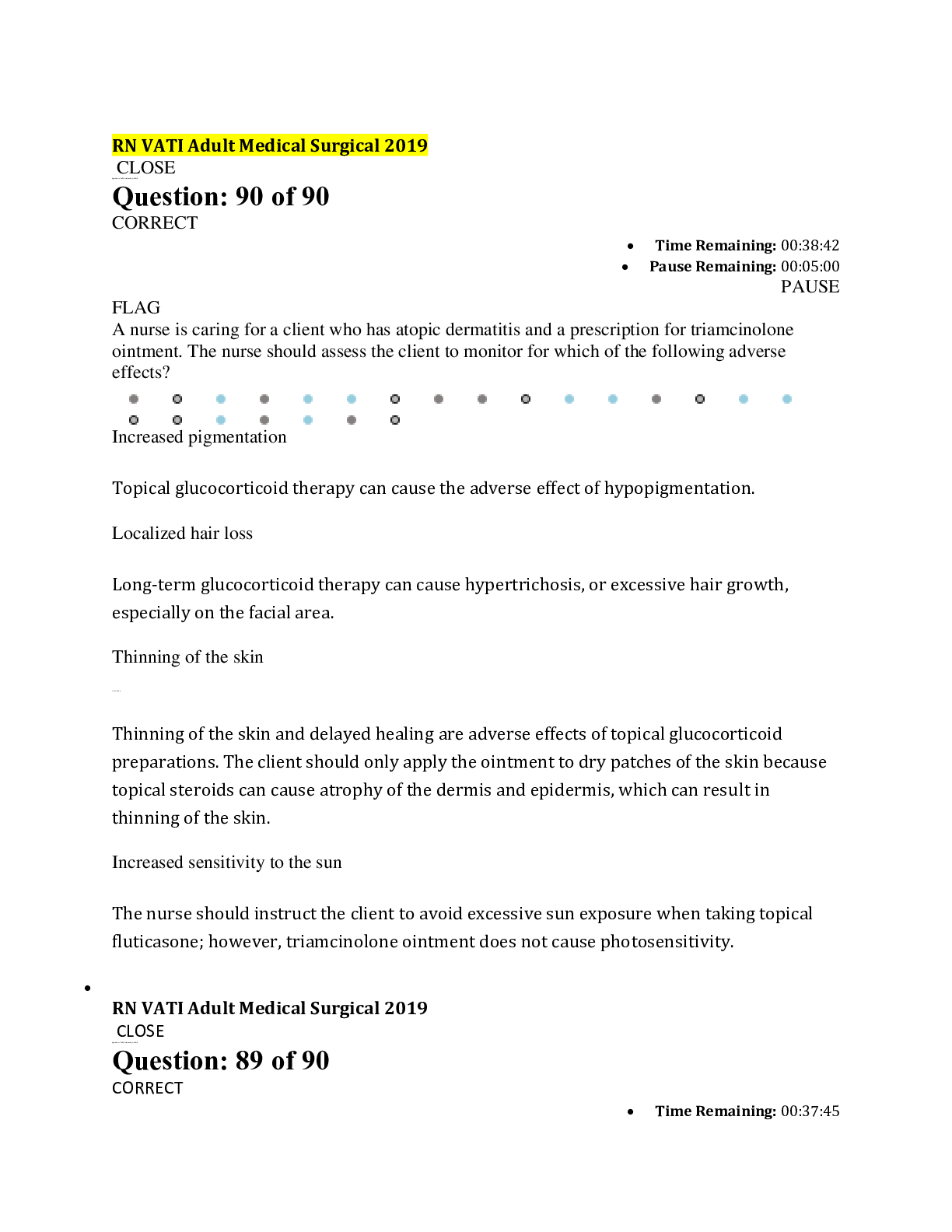
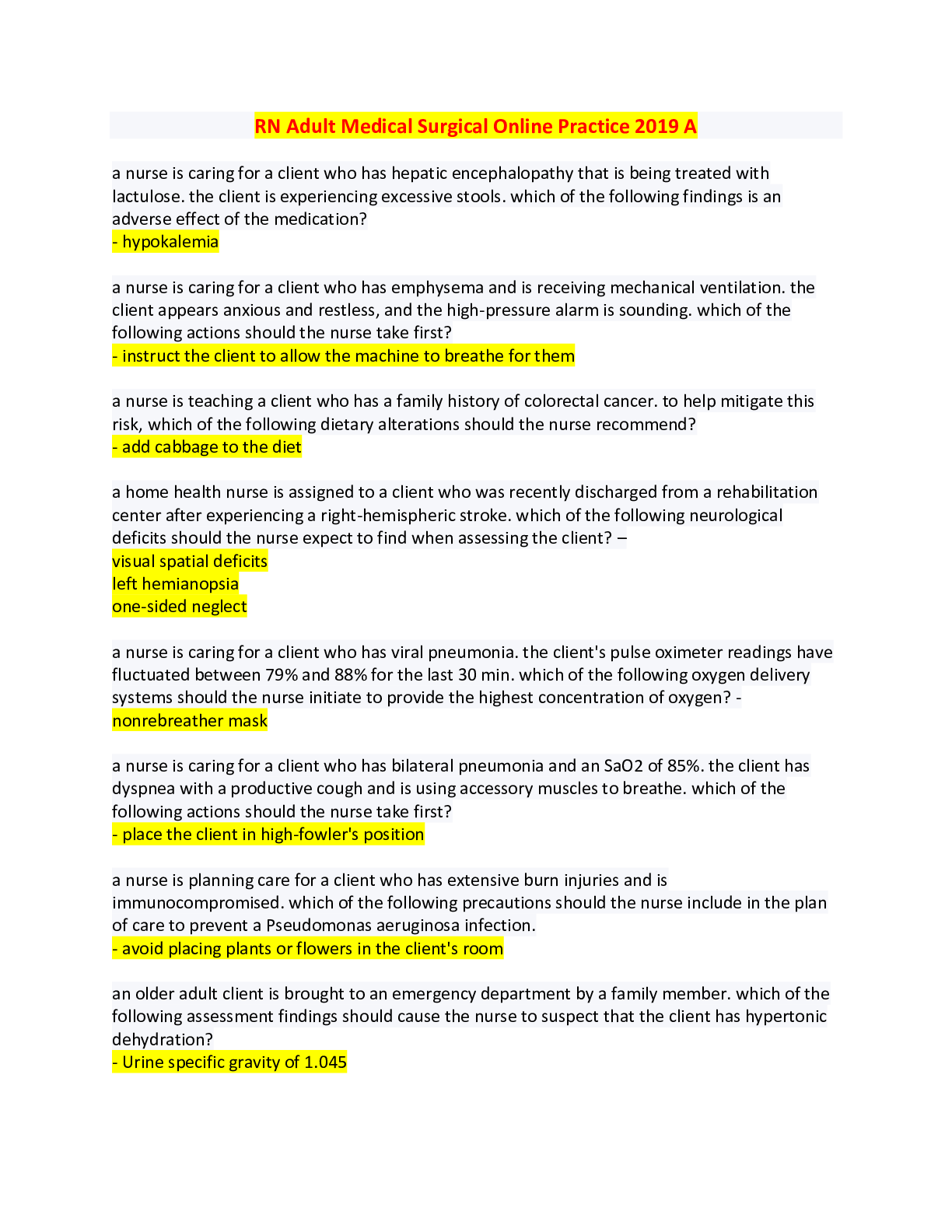

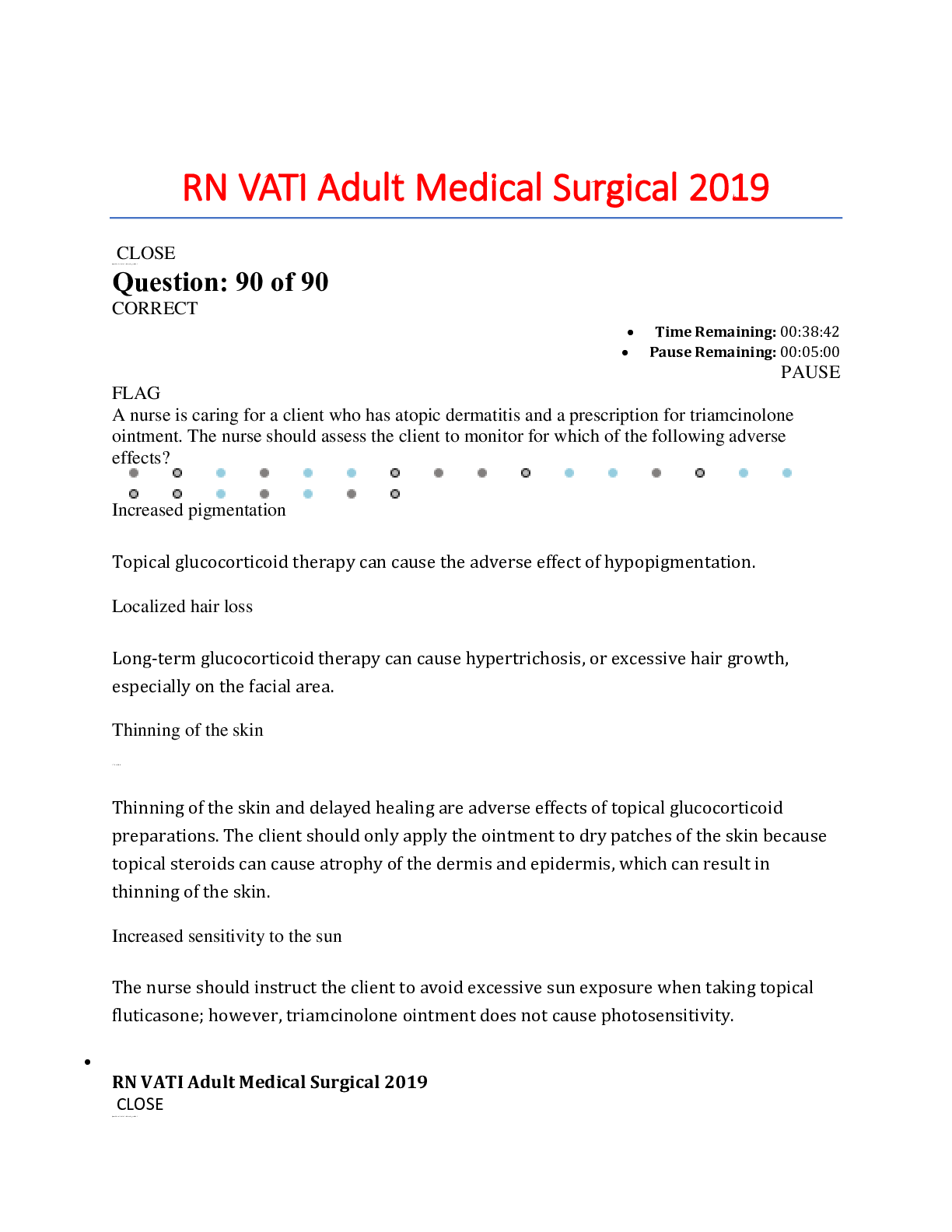
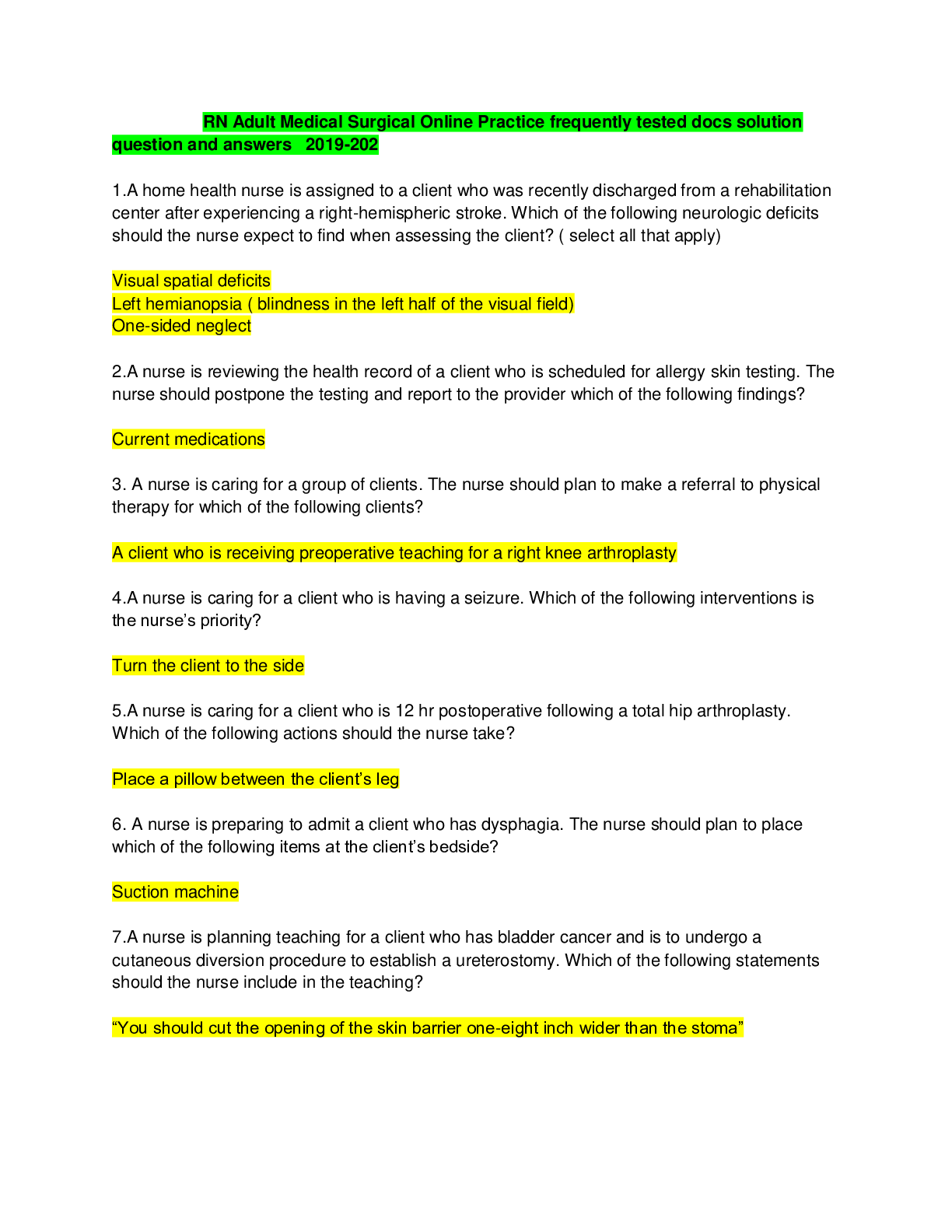
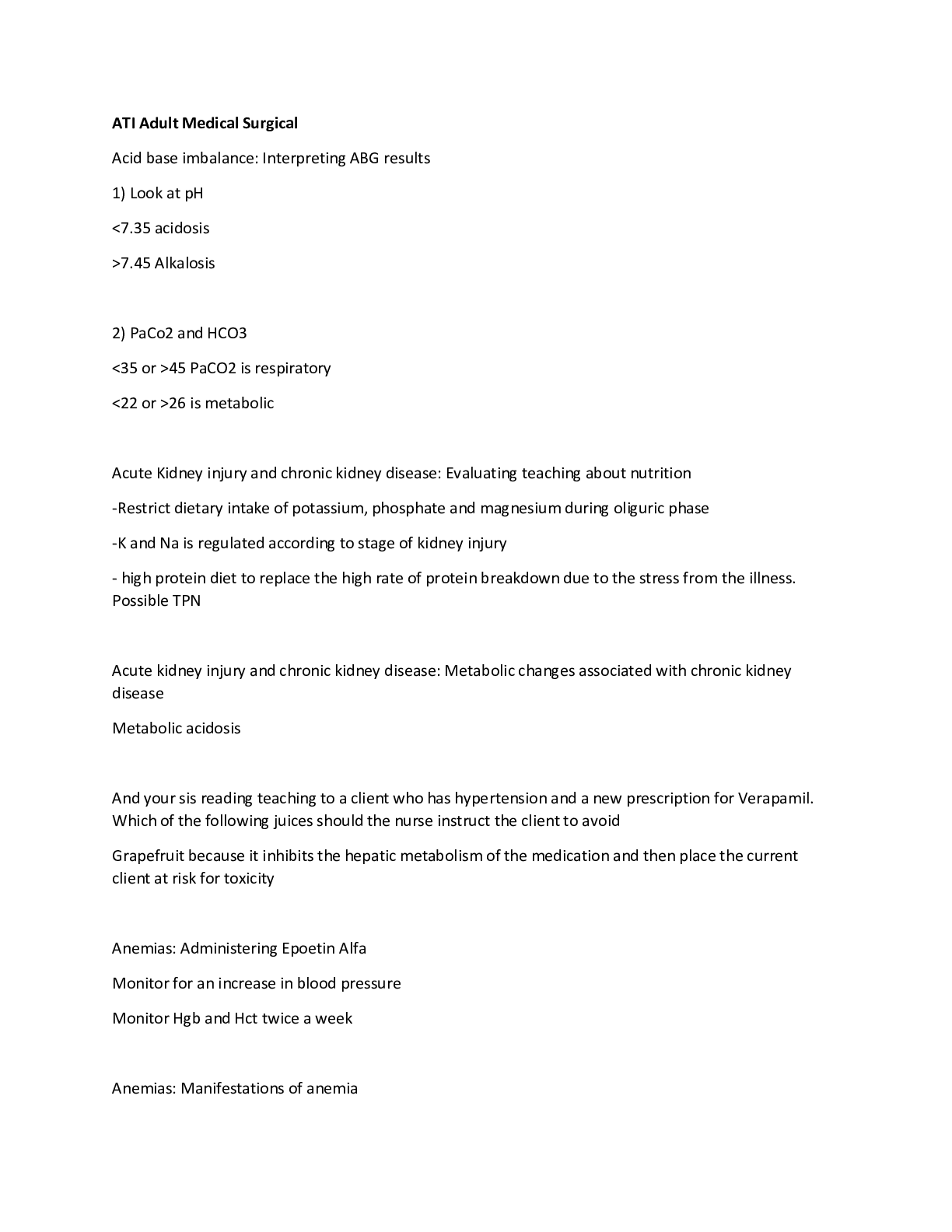

.png)


